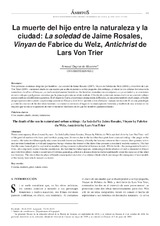Mostrar el registro sencillo del ítem
La muerte del hijo entre la naturaleza y la ciudad: la soledad de Jaime Rosales, Vinyant de Fabrice du Welz, Antichrist de Lars von Triers
| dc.contributor.author | Duprat de Montero, Arnaud | |
| dc.date.accessioned | 2014-10-01T07:54:41Z | |
| dc.date.available | 2014-10-01T07:54:41Z | |
| dc.date.issued | 2013 | |
| dc.identifier.issn | 1575-2100 | |
| dc.identifier.issn | 2386-4494 | |
| dc.identifier.uri | http://hdl.handle.net/10396/12361 | |
| dc.description.abstract | Tres películas coetáneas dirigidas por hombres –La soledad de Jaime Rosales (2007), Vinyan de Fabrice du Welz (2008) y Antichrist de Lars Von Trier (2009)– cuentan el duelo de una madre que acaba de perder a su hijo pequeño. Sin embargo, al situar las dos últimas historias en la naturaleza –la selva o el bosque–, se vuelven rápidamente fantásticas –las heroínas reanudan con sus orígenes, su yo verdadero y se convierten en seres salvajes y peligrosos– mientras que la primera presenta un relato realista. El hecho de contar este mismo duelo en un contexto urbano parece explicar esta diferencia genérica. Si el origen de Adela, el personaje protagonista de Rosales, se encuentra también en el campo, el hecho de que aparezca ahí su padre –un personaje ausente en Vinyan y Antichrist– permite a ésta afirmarse –aunque sea lejos de él– en una genealogía y evitar los excesos de las dos otras heroínas. La ciudad es entonces el lugar de la emancipación femenina y también de una soledad de las mujeres que favorece la aparición de nuevos modelos familiares en los que los hombres quedan excluídos. | es_ES |
| dc.description.abstract | Three contemporary films directed by men - La Soledad by Jaime Rosales, Vinyan by Fabrice du Welz and Antichrist by Lars Von Trier – tell of the grief of mothers who have just lost their young sons. However, due to the fact that their plots have a natural setting – the jungle or the woods – the latter two films rapidly take a turn towards horror and fantasy whereby the heroines return to their sources, their genuine selves and are transformed into a wild and dangerous beings whereas the former of the three films presents a resolutely realistic narrative. The fact that the same form of grief is explored in an urban setting seems to explain that difference in style. Whilst Adela – the protagonist in Rosales’s film – also originally comes from the countryside, the fact that her father appears, contrasting with the absence of such a character in Vinyan and Antichrist allows Adela to assert herself within a genealogy, albeit at a distance from her father and thereby avoid the excesses of the other two heroines. The city is thus the place of female emancipation and also of a certain solitude which encourages the emergence of new models of the family from which men are excluded. | es_ES |
| dc.format.mimetype | application/pdf | es_ES |
| dc.language.iso | spa | es_ES |
| dc.publisher | Asociación de Estudios de Ciencias Sociales y Humanidades | es_ES |
| dc.rights | https://creativecommons.org/licenses/by-nc-nd/4.0/ | es_ES |
| dc.source | Ámbitos (30), 49 - 53 (2013) | es_ES |
| dc.subject | Cine | es_ES |
| dc.subject | Madres | es_ES |
| dc.subject | Duelo | es_ES |
| dc.subject | Ciudad | es_ES |
| dc.subject | Naturaleza | es_ES |
| dc.subject | Cinema | es_ES |
| dc.subject | Mothers | es_ES |
| dc.subject | Grief | es_ES |
| dc.subject | Nature | es_ES |
| dc.subject | Cities | es_ES |
| dc.title | La muerte del hijo entre la naturaleza y la ciudad: la soledad de Jaime Rosales, Vinyant de Fabrice du Welz, Antichrist de Lars von Triers | es_ES |
| dc.type | info:eu-repo/semantics/article | es_ES |
| dc.rights.accessRights | info:eu-repo/semantics/openAccess | es_ES |

